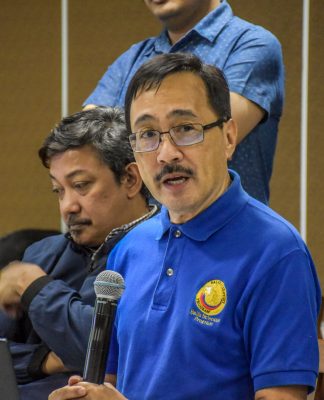BIODIVERSITY, improved healthcare, and the exploration of the relationship between the environment and diseases were the focus of some of the best undergraduate scientific theses for the academic year 2014 to 2015.
Although the Philippines can be considered a hotspot for new species, Biology students Raphael Hizon, Joseph Lopez, Nicole Nucom and Jolo Panaligan noticed that new species often face extinction before getting popular attention.
Panaligan said this was what brought them to conduct their study in the hope of identifying new species collected from Mt. Natib in Bataan and evaluate their components and possible medicinal potential.
Genetic material were extracted and sequenced from the Pyrostria and Uncaria plant specimens, followed by a phytochemical analysis and phylogenetics to identify their chemical groups and gauge their medical and pharmaceutical potential.
Microbiology students Mariah Carbonell, Yonnalyn Dalangin, Margareth Isagan and Ana Lapirafocused on the presence of fungi-like Myxomycetes in volcanic areas and its potential for various uses.
In their study, Isagan and her colleagues assessed plant litter, vines and twigs collected from Mt. Makulot and Napayong Island, Batangas for 12 weeks. Data such as the color, shape, spores and presence of lime were recorded, tabulated and subjected to ecological analysis.
They found out that the ground litter from Mt. Makulot had higher taxonomic diversity, or the lowest ratio between the number of species and the number of genera among their study sites. Meanwhile, Napayong Island had higher diversity in terms of richness of species and their relative abundance.
The study concluded that volcanic areas are favorable habitats for Myxomycetes, including its potential to harbor many undiscovered slime mold species.
“This is the first study to compare Myxomycete species in Mt. Makulot within Taal Lake, and is also the first Myxomycetes occurrence and diversity report in Napayong Island,” Isagan said.
She added that Myxomycetes have a potential to contribute to biodiesel production as well as become sources of antibiotic compounds and cytotoxic compounds (substances dangerous to cells).
In the Applied Mathematics department, the top thesis focused on the comparison of the occurrence of measles in the Philippines and Nigeria using climate variables.
Measles is an airborne viral infection affecting the respiratory and the immune systems, commonly leading to pneumonia, diarrhea and spot-like rashes. The Center for Disease Control and Prevention considers measles as one of the most contagious diseases worldwide and is found to be very lethal to infants and toddlers, with outbreaks recorded in the country last 2010, 2011 and 2014.
Audel Ravelo and Jan Tiu compared the tropical conditions with the occurrence of measles in their study titled, “Correlation Analysis of Measles Occurrence with Climate Variables: Comparative Study Between Luzon, Philippines and Ondo State, Nigeria.”
“The Philippines and Nigeria have very similar climate conditions,” College of Science Assistant Dean Ma. Carlota Decena, also a co-author of the study, said.
“Comparing these to the occurrence of measles in the two countries can be a good way of assessing what could be done to lessen the cases of measles in the country.”
The study examined if a research in Ondo State, Nigeria on the relationship of climate variables with measles occurrence could be applied in the Philippine setting.
Various tools were used to examine data gathered from the Department of Health and the Philippine Atmospheric Geophysical and Astronomical Services Administration.
Results showed that unlike in Ondo State, climate variables had little relationship with measles occurrence in the Philippines. The study explained that unlike Luzon, which comprises of several islands, the Ondo state is a land mass.
Difference in population, basic hygiene and sanitation, livelihood and environmental conditions are also factors that affect the spread of measles in the two settings.
“Hearsay is very rampant in our country. People usually just prepare or take safety measures whenever the sickness is already growing or epidemic,” Tiu said, adding that the study suggested year-round anti-measles campaigns due to the fact that measles are found to be not necessarily seasonal in nature.
Faculty of Pharmacy
The usage of the molecule adiponectin as a potential marker or identifier for type 2 diabetes has been the focus of Medical Technology students Shannen Langcamon, Denise Magdamit and Christine Tan in their study.
Adiponectin is a peptide, or a naturally occurring biological molecule, that can act as a hormone with anti-inflammatory and insulin-sensitizing properties. Low levels of adiponectin have been associated with increased risks of type 2 diabetes among different nationalities, but there is a lack of research in its effects to Filipinos.
Type 2 diabetes occurs when the body cannot use the insulin it produces, which also stems from excess body weight and physical inactivity.
The study analyzed blood samples for properties such as blood glucose, insulin and adiponectin, while at the same time determining its association with the presence of type 2 diabetes mellitus and insulin resistance.
The study concluded that low adiponectin levels are associated with insulin resistance and could serve as a biomarker for Type 2 diabetes mellitus. However, researchers suggested a new study with a larger scale might be needed to further support their conclusion.
















